How to Build Pillar & Cluster Pages for B2B Businesses (Step-by-Step Guide)

Here’s a sobering reality: B2B buyers consume multiple pieces of content before ever contacting sales. Yet most B2B websites have scattered, unorganized content that fails to guide these buyers through their journey.
Enter pillar and cluster pages, a strategic content framework where comprehensive pillar pages on broad topics connect to cluster pages that dive deep into specific subtopics. Together, they create an organized content ecosystem that both search engines and buyers love.
Why this matters for your B2B business:
- Rank higher on Google – Organized topic clusters signal expertise and help you dominate search results for your industry
- Capture qualified leads at every stage – Address different decision-maker concerns with interconnected content
- Keep prospects engaged longer – Strategic internal linking significantly increases time-on-site, moving buyers closer to conversion
- Support complex B2B buying cycles – Multiple stakeholders need different content angles; pillar/cluster strategy covers all bases
- Maximize content ROI – Transform existing scattered blog posts into a high-performing SEO asset
This guide covers everything you need to build high-performing pillar and cluster pages, plus a free template to get started immediately.
What Are Pillar & Cluster Pages?
Pillar Pages
A pillar page is a comprehensive, long-form piece of content (typically 2,000-2,500 words) that broadly covers a core topic relevant to your business. Think of it as your definitive guide on a subject, broad enough to branch into multiple subtopics, but focused enough to rank well.
The spider web analogy: Your pillar page sits at the center of a web. Each strand connects to cluster content that explores specific aspects of your main topic. The pillar links to all clusters, and all clusters link back to the pillar.
Cluster Pages
Cluster pages are focused articles (800-1,200 words) that dive deep into specific subtopics related to your pillar. Each cluster targets one keyword and provides detailed information that complements your pillar page.
How they work together: If your pillar page is “Content Marketing for SaaS,” your clusters might be “How to Write SaaS Blog Posts,” “SaaS Content Distribution Strategies,” and “Content Marketing Metrics for SaaS.”
Why B2B Businesses Need Them
- ✅ Better Google rankings – Topic clusters demonstrate topical authority, helping you rank for competitive keywords
- ✅ Longer site engagement – Visitors naturally explore interconnected content, increasing session duration
- ✅ Address multiple decision-makers – B2B purchases involve multiple people; each cluster can speak to different stakeholder concerns
- ✅ Establish thought leadership – Comprehensive content positions your brand as the industry expert
3 Types of Pillar Pages
Resource Pillar
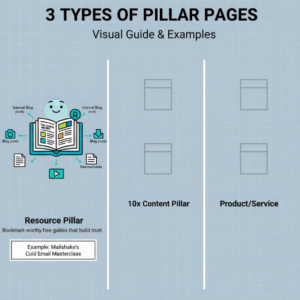
A comprehensive, free guide that serves as a bookmark-worthy reference. These pages link to extensive internal content and position your brand as generous with knowledge.
Example: Mailshake’s Cold Email Masterclass—an 8-lesson series with each lesson linking to pillar and cluster pages.
Best for: Companies building trust and capturing top-of-funnel traffic.
10x Content Pillar
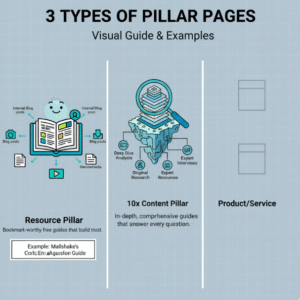
An in-depth exploration that covers a topic from every angle, mixing internal and external links. These pages attempt to answer every possible question about a subject.
Example: Help Scout’s Customer Acquisition guide breaks down subtopics with information, insights, and recommended reading.
Best for: Businesses competing in saturated markets needing to differentiate through depth.
Product/Service Pillar
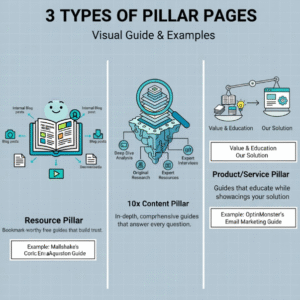
A pillar page that educates while positioning your solution. Answer common questions about your offering while providing value.
Example: OptinMonster’s Email Marketing Guide covers the topic comprehensively while showcasing their tool as the solution.
Best for: Companies with longer sales cycles needing to nurture and educate prospects.
Planning Your Strategy (Before You Write)
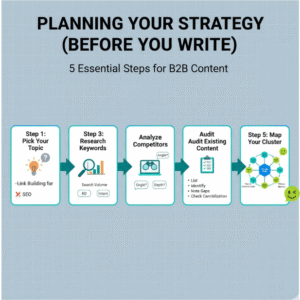
Step 1: Pick Your Topic
Choose a topic broad enough to support 8-10 cluster articles but specific enough to rank.
- ❌ Too broad: “SEO” (thousands of competing keywords, impossible to rank)
- ✅ Just right: “Link Building for SEO” (focused, manageable, rankable)
Test your topic: Can you list 8-10 specific subtopics immediately? If yes, you’ve found your pillar topic.
Step 2: Research Keywords
Use Ahrefs, SEMrush, or Google Keyword Planner to validate your topic.
What to look for:
- Search volume: 1,000+ monthly searches
- Keyword difficulty: Medium (30-60)
- Search intent: Informational (“what is,” “how to,” “guide to”)
Pro tip: Look at “People also ask” and related searches to identify cluster topics.
Step 3: Analyze Top 10 Competitors
Study the first page of Google results for your target keyword.
Questions to ask:
- What angle did they take? (Generic overview vs. unique perspective)
- What’s missing from their content? (Gaps you can fill)
- How comprehensive is their coverage? (Can you go deeper?)
- What’s their word count? (Aim to beat it by 20-30%)
Your opportunity: Find the unique angle no competitor has covered.
Step 4: Audit Your Existing Content
Before creating new content, inventory what you already have.
Review process:
- List all existing blog posts related to your pillar topic
- Identify which posts can become cluster pages (with optimization)
- Note gaps where new cluster content is needed
- Check for cannibalization (multiple posts competing for the same keyword)
Smart move: You don’t need all-new content. Repurpose existing articles into your cluster strategy.
Step 5: Map Your Cluster
Create a visual map showing your pillar at the center and 8-10 clusters branching out.
Each cluster should:
- Target one specific keyword
- Answer one aspect of the pillar topic
- Be linkable from a section in your pillar page
Example cluster map for “Email Marketing for B2B”:
- How to Build a B2B Email List
- Email Segmentation Strategies
- B2B Email Copywriting Tips
- Email Automation Workflows
- Email Deliverability Best Practices
- A/B Testing for B2B Emails
- Email Marketing Metrics That Matter
- GDPR Compliance for Email Marketing
Pillar Page Template (What to Include)
Title (H1)
Include your main keyword naturally.
Winning formulas:
- “[Topic]: Your Complete Guide”
- “What is [Topic]? (And Why It Matters for [Audience])”
- “How to [Achieve Result] with [Topic]”
Example: “Content Marketing for SaaS: Your Complete Guide”
Introduction
Hook readers with their pain point, then promise a solution. Include your main keyword in the first paragraph.
Structure:
- Compelling stat or problem (1-2 sentences)
- Introduce your topic as the solution (1 sentence)
- Preview what they’ll learn (2-3 bullets)
Table of Contents (Shortcuts)
Create jump links to each major section. This makes your content skimmable and improves user experience.
Format:
Quick Navigation:
- What is [Topic]?
- Why [Topic] Matters
- How to [Do Topic]
- [Topic] Best Practices
- Common Mistakes
Definition Section
This is your featured snippet opportunity. Write a clear, concise definition around 300 characters.
Formula: “[Your topic] is [clear one-sentence explanation that a 12-year-old would understand].”
Example: “Email marketing is the practice of sending commercial messages to a group of people via email to build relationships, promote products, or drive sales.”
Why this matters: Google pulls this for position zero (featured snippets).
5-7 Body Sections
Each section summarizes one cluster topic and links to the full article.
Structure for each section:
H2: [Cluster Topic Title]
2-3 sentences introducing the concept and why it matters.
Key points:
- Important point 1
- Important point 2
- Important point 3
→ Read our complete guide: [Link to cluster article with anchor text]
Example:
H2: How to Build Your B2B Email List
Growing a quality email list is the foundation of successful email marketing. B2B lists require different strategies than B2C—you’re targeting decision-makers, not consumers.
Effective list-building tactics:
- Create gated content that solves specific business problems
- Use LinkedIn lead gen forms for professional audiences
- Implement exit-intent popups with compelling offers
FAQ Section
Answer 3-5 commonly searched questions using SEMrush or Ahrefs “Questions” feature.
Format:
- Q: [Question]
- A: 2-3 sentence answer with your keyword naturally included
Pro tip: Format these with proper FAQ schema markup for rich snippets.
Conclusion
Provide a quick recap and one final insight. End with a soft call-to-action.
Structure:
- Main takeaway (2 sentences)
- One bonus pro tip
- Next step (download template, book demo, read related content)
Optimal Specs
- Word count: 2,000-2,500 words
- Sections: 5-7 body sections minimum
- Internal links: 8-12 links to cluster pages
- Images: 3-5 relevant visuals, screenshots, or diagrams
- Headers: Clear H2 and H3 hierarchy
Reading level: 8th-9th grade (use Hemingway App to check)
Writing Your Cluster Content
Cluster Page Characteristics
- Length: 800-1,200 words (more focused than pillar)
- Focus: ONE specific keyword and subtopic
- Depth: Detailed how-to or comprehensive exploration
- Links: Must link back to pillar page (usually in intro or conclusion)
Example: If your pillar is “Project Management for Agencies,” a cluster might be “How to Use Gantt Charts for Agency Projects” (specific, actionable, supports pillar).
Linking Strategy
From pillar to clusters:
- Link to every cluster page from relevant sections
- Use descriptive anchor text (“learn how to build email lists” not “click here”)
- Natural placement within content, not forced
From clusters to pillar:
- Link back in introduction: “This guide is part of our comprehensive [Pillar Topic] resource”
- Reference pillar in conclusion: “For more strategies, see our complete guide to [Pillar Topic]”
Between clusters:
- Link to related clusters when naturally relevant
- Creates a web of interconnected content
- Keeps visitors engaged longer
How Many Clusters?
Starting point: 8-10 cluster articles minimum
Growth strategy: Add 2-3 new clusters quarterly as you identify content gaps or new keyword opportunities.
Sweet spot: 15-20 clusters per pillar gives comprehensive coverage without overwhelming maintenance.
Optimization Checklist
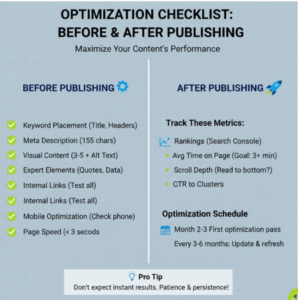
Before Publishing
- ✅ Keyword placement: Include in title, intro paragraph, 2-3 headers, and conclusion
- ✅ Meta description: 155 characters with keyword and compelling hook
- ✅ Visual content: 3-5 images with descriptive alt text containing keywords
- ✅ Expert elements: Include quotes from SMEs, original research, or case studies
- ✅ Internal links: Verify all cluster links work correctly
- ✅ Mobile optimization: Content is readable and navigable on phones
- ✅ Page speed: Loads in under 3 seconds (use Google PageSpeed Insights)
- ✅ Unique angle: Your perspective differs from top 10 competitors
After Publishing
Track these metrics:
- Rankings in Google Search Console (track pillar + cluster keywords)
- Average time on page (goal: 3+ minutes for pillar pages)
- Scroll depth (are people reading to the bottom?)
- Click-through rate from pillar to clusters
Optimization schedule:
- Month 1: Monitor initial rankings and user behavior
- Month 2-3: Make first optimization pass based on data
- Every 3-6 months: Update with fresh data, new examples, emerging trends
Pro tip: Don’t expect instant results. Quality pillar pages often take 2-3 months and multiple optimization rounds to reach page one.
Common Mistakes to Avoid
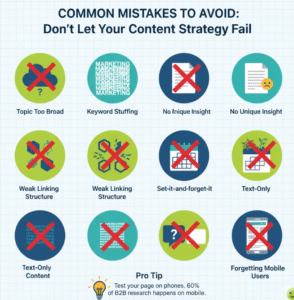
❌ Topic too broad – Can’t rank for “marketing.” Can rank for “email marketing for SaaS companies.”
❌ Keyword stuffing – Write naturally. Your keyword should appear 8-10 times maximum, not 50.
❌ No unique insight – Generic content copied from competitors won’t rank. Add expert interviews, original data, or fresh perspectives.
❌ Weak linking structure – Every cluster must link to pillar AND pillar must link to every cluster. Missing links break the strategy.
❌ Text-only content – Pages without images see 40% lower engagement. Add visuals, diagrams, screenshots.
❌ Set-it-and-forget-it mentality – Pillar pages require ongoing optimization. Plan to update quarterly.
❌ Skipping FAQs – This section captures long-tail keywords and featured snippets. Don’t leave it out.
❌ Forgetting mobile users – 60% of B2B research happens on mobile. Test your page on phones.
Conclusion
Pillar and cluster pages aren’t just an SEO tactic], they’re a long-term content asset that positions your B2B business as the definitive authority in your space.
Remember the key principles:
- Start with strategic planning, not writing
- Use the template to structure every pillar page consistently
- Build clusters systematically (8-10 to start)
- Optimize continuously based on performance data
Your next step: Download our free Pillar Page Template + Cluster Planning Worksheet to start mapping your content strategy today.
Within 3-6 months of implementing this strategy, you’ll see improved rankings, longer site sessions, and more qualified leads, all from content working harder for your business.

